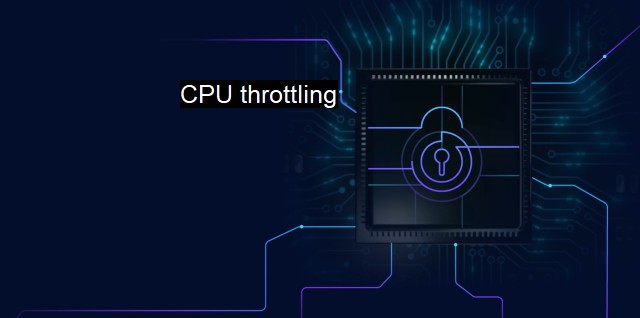What is CPU throttling?
Understanding CPU Throttling: From Safety Feature to Malware Vulnerability
CPU throttling, to put it simply, is the limiting or constraining mechanism used to control or manage the computing power of a Microprocessor. In the realm of cybersecurity and antivirus solutions, CPU throttling plays a significant role in terms of optimizing the system performance while executing crucial operations such as scanning for and identifying potential threats.Technically, CPU throttling works by dynamically adjusting the clock speed of the CPU, the speed at which a processor can execute instructions. It could be activated manually by a user or automatically by the system firmware, based on the current operating conditions. At times of extreme CPU usage or high ambient temperature, the microprocessors are designed to lower their clock speed to prevent any undesirable consequences like overheating and subsequent compromise of its expected performance and life span. Given that the system's processor is a core component of any computing device, such protective measures are mostly inbuilt into the CPU design.
The actual connection of CPU throttling to cybersecurity might not be overtly clear at first glance; a directed view would provide clues to its significant relevance. First and foremost, modern-end antivirus solutions require substantial system resources, specifically CPU power, to scan the intricate designs of malware and other potential security threats. Such operations can inflate CPU usage to extreme peaks thereby causing possible thermal stress to the processor which, in turn, could potentially harm your overall system. As such, CPU throttling emerges as an essential mechanism to complement the antivirus operations whilst preserving system balance and performance.
Another context to consider is cryptojacking, a serious cybersecurity threat, where unauthorized individuals maliciously utilize a victim's computing power to mine cryptocurrencies. Crypto Miners typically push for maximum CPU usage to optimize their gains, thereby triggering CPU throttling. In abnormal or uncontrolled conditions, this could lead to system overheat or fatal failures. A robust antivirus solution that efficiently manages CPU usage and validates CPU throttling can perceptibly guard against such malicious activities.
Also, linking CPU throttling with In-depth, heuristic threat analysis provides another appreciation to its prominence. Nowadays, strong malware can cope with standard antivirus evaluations and may require a more thorough, CPU-intensive heuristic inspection to be completely found and deactivated. But these scans are known to drive up CPU users. If an antivirus scanner was handling these analyses without controlling the CPU usage, the device would become low performing and likely to crash. Here, the antivirus software can leverage CPU throttling to ensure effective resource optimization, prevent system overheating and guarantee user's seamless experience while ensuring maximum security.
When threat detection combines with data analytics, the imposed load on the system amplifies, which makes antivirus software more CPU-intensive. Efficient CPU throttling during these computational tasks can help balance resource usage and maintain overall system usability and reliability.
CPU throttling emerges as a critical utility in the domain of cybersecurity, serving as the defender of the microprocessor and hence directly blocking any attempts to impact the system performance negatively. It helps antivirus solutions to successfully deliver intended outcomes peacefully and efficiently while ensuring optimum user satisfaction and cyber safety. Throttling’s role in contemporary cybersecurity practices exhibits its importance in managing device operation without compromise—and unifying threat protection with system sustainability.

CPU throttling FAQs
What is CPU throttling and how does it relate to cybersecurity?
CPU throttling is a technique used by CPU manufacturers to reduce the power consumption and heat generated by the CPU. In the context of cybersecurity, CPU throttling can be used by antivirus software to limit the CPU usage of malicious programs or processes, reducing their ability to perform harmful actions such as data theft or mining.Why would a CPU be throttled by antivirus software?
Antivirus software may throttle the CPU if it detects a high CPU usage by a program or process that is not essential for system operation or is known to be malicious. Throttling the CPU can help prevent the program from disrupting the system or causing damage.Can CPU throttling affect system performance?
Yes, CPU throttling can affect system performance, as it limits the maximum processing power of the CPU. However, the impact on performance may be minimal depending on the type and severity of throttling applied, and the overall system configuration.Is CPU throttling a foolproof method to prevent cyber attacks?
No, CPU throttling alone is not a foolproof method to prevent cyber attacks. While it can limit the damage caused by malicious programs, it may not provide complete protection against sophisticated attacks that can bypass or disable throttling measures. Other security measures such as firewalls, intrusion detection systems, and regular software updates are also essential to maintain system security.| | A | | | B | | | C | | | D | | | E | | | F | | | G | | | H | | | I | | | J | | | K | | | L | | | M | |
| | N | | | O | | | P | | | Q | | | R | | | S | | | T | | | U | | | V | | | W | | | X | | | Y | | | Z | |
| | 1 | | | 2 | | | 3 | | | 4 | | | 7 | | | 8 | | |||||||